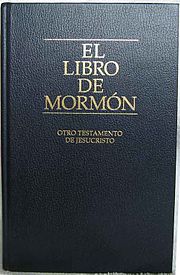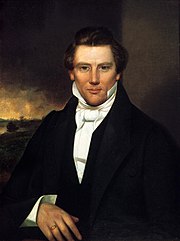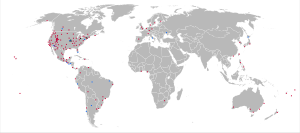The Church of Jesus Christ of Latter-day Saints
The Church of Jesus Christ of Latter-day Saints is the main Christian denomination belonging to the Latter-day Saint Movement, also known as Mormonism. It was founded by American Joseph Smith on April 6, 1830, in western New York. Smith initially intended to establish the New Jerusalem in North America, called Zion. In 1831, the church moved to Kirtland, Ohio (eastern border of Zion), and began to establish an outpost in Jackson County, Missouri, where he planned to eventually move the church headquarters (central Zion).
This organization is also known informally as the Mormon Church (a nickname derived from the Book of Mormon) or LDS Church (an acronym for Latter Day Saints). names are not authorized by the organization and do not recommend their use. Its members call themselves "members of the Church of Jesus Christ of Latter-day Saints" or "members of the Church of Jesus Christ".
Their sacred texts, other than the Bible, are the Book of Mormon, the Doctrine and Covenants, and the Pearl of Great Price. These last books are the object of harsh criticism by various Protestant and Catholic denominations closer to traditional and historical Christianity, some of which do not recognize the baptisms practiced by this Church.
After the death of Joseph Smith, other currents arose simultaneously among some members of the Church, such as the Community of Christ, with its own presidents and congregations. Certain more fundamentalist branches also arose, such as the fundamentalist Church of Jesus Christ of Latter-day Saints, considered apostate, which maintained the practice of polygamy, originally practiced by Smith.
This Church currently has around sixteen million members and sixty-five thousand missionaries distributed in thirty thousand congregations (called Stakes, Wards and/or Branches) located in around one hundred and forty countries. 46% of the members reside in the United States and Canada, and 38% in Latin America. Its religious and spiritual center is Salt Lake City, capital of the state of Utah, similar to Vatican City for Catholics. home to the Tabernacle Choir at Temple Square and Brigham Young University, church members make up 60% of the population.
History
Foundation
The church was founded by Joseph Smith on April 6, 1830, in western New York state, under the name The Church of Jesus Christ. Early converts were drawn to the church by the newly published Book of Mormon which claims to tell the story of the ancient inhabitants of the Americas and a personal visitation by Jesus Christ after his resurrection.
Many Latter-day Saints begin their founding story by telling a story they call the First Vision. In 1820 Smith said, in the town of Palmyra, New York, God and Jesus Christ contacted him in answer to his prayer for the state of his soul. Smith says that in the vision Jesus Christ forgave his sins and told him to disapprove and considered as false all the creeds of the existing churches until then. Between 1832 and 1842, Smith wrote at least four accounts of the First Vision. These accounts are similar in many respects, but differ in both their emphasis and some details. The 1838 account was published in the book Pearl of Great Price, one of the standard works of the church.
Smith also said that on September 21, 1823 he received a second vision, where an angel named Moroni told him that on a hill near Palmyra he would find buried manuscripts on gold plates, which would be a compendium of prophets. belonging to ancient America. Such writings, written in a strange language, would supposedly be translated by Smith thanks to seer stones called Urim and Thummim. This book, called the Book of Mormon, constitutes one of the canonical texts of religion. Smith, with the help by Martin Harris, Oliver Cowdery, and David Whitmer, first published the book in 1830 in English. The first translation into Spanish and other languages appeared in 1886.
Migrations and struggles
In 1831, Smith and his early followers moved to Kirtland, Ohio, and established a settlement in Jackson County, Missouri, where they intended to make their headquarters. However, in 1833, Missouri settlers violently expelled them and members of the Church failed in their subsequent paramilitary operation to reclaim the land. Despite this, the Church managed to expand for a time in Kirtland, but had to leave abruptly in 1838, following a financial scandal that led to various disaffections and for which Smith had to face several lawsuits for improper enrichment and the creation of an illegal bank. Smith regrouped the rest of his followers in a settlement called Far West, in Missouri, where tensions with the former settlers escalated to the point of to violent conflicts.
In 1839 members of the church settled on the banks of the Mississippi River, where they founded the city of Nauvoo, which began to grow rapidly thanks to the settlement of new converts brought by church missionaries. About this time, Joseph Smith began to introduce polygamy among those closest to him and to establish new ceremonies that supposedly allowed the just to become gods.
Joseph Smith and his brother Hyrum were murdered on June 27, 1844 while detained in a Carthage, Illinois jail. Because Hyrum was Smith's designated successor, a succession crisis broke out that caused several schisms in the church and from which Brigham Young would emerge as leader of the majority of the members, first based in Nebraska, and from 1847 in the Utah. The main branches of the Latter Day Saint Movement that arose were the following:
The doctrine of polygamy originally promoted by Smith was publicly formalized in 1852. Ten years later, various laws began to be enacted in the United States against this practice. In 1885, the state of Idaho prohibited it, a decision ratified by the United States Supreme Court in 1890. Church members thus lost their right to vote. Under the leadership of Church President Wilford Woodruff, a manifesto was declared, now included in the Doctrine and Covenants., in which he officially announced the end of plural marriage.
20th century
After the annexation of Utah to the United States of America on January 4, 1896 and being under the approval and guarantee of the Constitution of that nation, the Church began to expand to neighboring states, and later to the entire country. It currently ranks fourth in the broad religious spectrum in the United States. In the middle of the XX century, it began its expansion to Latin America and Europe. He is currently actively proselytizing in Africa, parts of Asia, and Eastern Europe.
During the 20th century, the church grew substantially and became an international organization, due in part to the expansion of missionaries throughout the world. In the year 2000, the church reported 60,784 missionaries, and global church membership stood at just over 11 million. Worldwide membership exceeded 16 million in 2018. Just under half of the church's membership lives within the United States.
There have been several official changes to the organization during the modern era. In 1978, the church reversed its previous policy of excluding black men of African descent from the priesthood, which had been in place since 1852; members of all races can now be ordained to the priesthood. There are also periodic changes in the structure and organization of the church, primarily to accommodate the growth of the organization and its growing international presence. For example, since the early 20th century, the church has instituted a Priesthood Correlation Program to centralize church operations and put them under a hierarchy of priesthood leaders. During the Great Depression, the church also began operating a church welfare system and has conducted humanitarian efforts in cooperation with other faith-based organizations, including Catholic Relief Services and Muslim Aid, as well as secular organizations such as the American Red Cross.
During the second half of the 20th century and early XXI, the church responded to various challenges to its doctrine and authority. Challenges have included increased secularization, and forged primary documents by Mark Hofmann that purport to contradict important aspects of official early church history.
In August 2018, church president Russell M. Nelson called on church members and others to stop using the terms "LDS", "Mormon" 3. 4; and "Mormonism" to refer to the church, its membership, or its belief system, and instead call the church by its full, official name.
Doctrinal beliefs and principles
This church considers itself "the only true and living church on the face of the whole earth".
His faith is based mainly on the belief in the teachings of Jesus Christ, and that they were given by divine revelation to the founder Joseph Smith. In addition to the Bible (in its LDS edition), his body of doctrine is completed with the books Book of Mormon, Doctrine and Covenants, and Pearl of Great Price, all published by Smith and considered holy books.
The members of this Church believe in the Holy Trinity, in a divine plan and in eternal life, a state of exaltation that can be achieved after the Last Judgment through a life based on faith, the obedience of the commandments, repentance, baptism by immersion, and confirmation by laying on of hands. This eternal life would be lived as a family, and those who achieve it could have spiritual children in Heaven. Members of the Church of Jesus Christ of Latter-day Saints believe in a Christian God with a tangible body, who chose Jesus Christ as his first son before the creation of the world and from there he created the rest of the human beings in his image and likeness. His throne would also be close to a star or planet called Kolob.
Her doctrines and liturgical covenants are documented in the book Doctrine and Covenants, published by Smith in 1835. Among her important doctrines is the Word of Wisdom, which describes the health code recommended by the Church. According to this doctrine, members of the Church must completely deprive themselves of the consumption of alcohol, coffee, tea and tobacco, as well as the use and trafficking of illicit drugs. Dietary recommendations are also included, in which, for example, the abuse of meat is discouraged.
The Church of Jesus Christ of Latter-day Saints opposes homosexuality; however, it accepts homosexuals as long as they remain chaste. It also considers induced abortion a sin; however, it accepts abortion exceptionally when fertilization is caused by rape or incest, when the life of the mother is in danger or when the fetus suffers from serious defects that will prevent it from living after birth. This Church does not prohibit the salute to the flag, military service or obedience to the country.
From the beginning of this Church, Joseph Smith allowed and practiced polygamy, a practice that was shared and disseminated by other church leaders such as Brigham Young and Heber C. Kimball, and is still practiced in some churches belonging to the Church. to the Latter-day Saint Movement; however, members of the contemporary Church of Jesus Christ of Latter-day Saints are prohibited from practicing polygamy or plural marriage. Church members also celebrate in their temples a ceremony called "eternal sealing," a marriage that is supposed to last for eternity, and not just until death do part.[citation needed] A analogous eternal bond ceremony is performed for children with their parents.
Inside their temples they wear a special type of white undergarment. There they also perform "vicarious baptism" (performed on behalf of their deceased ancestors) and other ordinances such as confirmation, marriage, and priesthood, but intended for deceased relatives.
Organization and financing
The Church of Jesus Christ of Latter-day Saints raises funds through tithes and fast votive offerings. Offerings consist of donating money used for two meals (lunch and dinner) at the same time you fast; they are collected every first Saturday or Sunday of the month and are used for charity. According to the business magazine BusinessWeek, a study conducted by Ryan Cragun, professor of sociology at the University of Tampa, estimated in 2012 that the Church received around eight billion dollars annually from tithe among its members, and that it was worth approximately forty billion dollars.
The Church is led by an exclusively male priesthood, divided into two types: the Melchizedek Priesthood and the Aaronic or Levitical Priesthood. As for its missionaries, most are between eighteen and twenty-one years old of age and their proselytizing activity lasts two years for men, a year and a half for women, and three years for older couples. Missionary training centers are located in Provo (United States), São Paulo (Brazil), Bogotá (Colombia), Preston (England), CDMX (Mexico), Auckland (New Zealand), Lima (Peru), Manila (Philippines)., Accra (Ghana) and Johannesburg (South Africa).
The members of the church meet every week in places that the membership calls «chapels», in which they carry out their services that consist of a first meeting where bread and water are distributed («The Holy Supper»), and the same members of the locality make speeches on different subjects. Later they meet depending on their age and sex in different organizations.
Another place of worship for members of the church are its characteristic temples, many of which share a common architecture. Only people baptized in the Church can enter these temples and after obtaining an official two-year document issued by two authorities: a bishop and a stake president. A distinctive feature of their architecture is the presence of a statue gold at the highest point of each building, which represents the angel Moroni.
In March 2014, the Church of Jesus Christ of Latter-day Saints website ranked number two in visited religious sites in the world, according to Alexa.
Controversies and criticisms
The Church of Latter-day Saints has been the subject of criticism since its early years in New York and Pennsylvania. In the late 1820s, criticism focused on Joseph Smith's claim to have been led to a set of gold plates from which the Book of Mormon was supposedly translated.
In the 1830s, the Church was criticized for Smith's handling of a bank failure in Kirtland, Ohio. After Mormons migrated west, there was fear and suspicion about the Church's political and military power of Latter-day Saints in Missouri, culminating in the Mormon War of 1838 and the Mormon Extermination Order (Missouri Executive Order 44) by Governor Lilburn Boggs. In the 1840s, criticism of the church included its theocratic aspirations in Nauvoo, Illinois. Criticism of the practice of plural marriage and other doctrines taught by Smith were published in the Nauvoo Expositor .The opposition led to a series of events that culminated in the death of Smith and his brother while they were imprisoned in 1844.
When the church began to openly practice polygamy under Brigham Young during the second half of the 19th century, the church became became the target of national criticism for that practice, as well as for the theocratic aspirations of the church in the Utah Territory. In 1852, Young introduced policies that discriminated against black men and women of African descent, which were not reversed until 1978. Beginning in 1857, the church also came under significant media criticism following the massacre of Mountain Meadows in southern Utah.
Academic critics have questioned Smith's legitimacy as a prophet, as well as the historical authenticity of the Book of Mormon and various points of criticism of the Book of Abraham. Criticism has widened to include claims of historical revisionism, homophobia, racism, and sexist politics. Notable critics of the 20th century include Jerald and Sandra Tanner and historian Fawn Brodie.
The Church's views on sexual minorities have also drawn criticism, such as 2008 calls by top church leaders to donate time and money to the California Proposition 8 campaign against same-sex marriage, sparking heated debate and protests from gay rights organizations and others. In 2009, the Church expressed support for a Salt Lake City ordinance protecting same-sex gays and lesbians against discrimination in employment and housing, but wanted an exception for religious institutions from this ordinance. A new controversy broke out in November 2015, when the church changed its guidance to lay leaders on unions between persons of the same sex and about minor children living in the home of a parent in a same-sex relationship, either natural or adopted. In April 2019, the church gave m backtracks on this policy, citing efforts to be more accepting of people from all backgrounds.
The Church's lack of transparency about its finances has drawn criticism from those who view Church practices as too secretive. The disclosure of the $100 billion fund controlled by the Church has drawn criticism from that the wealth of the Church may be excessive. Critical commentators have claimed that the Church uses its corporate structure to "optimize its asset and capital management by moving money and assets between [its] tax-exempt and regular businesses such as loans, donations or investments.
Contenido relacionado
Nestorianism
Theism
Leon Cathedral












